RTOS Neutrino in Industrial Computers
About a month ago a seminar, which had already become traditional, was held by the SVD Company Embedded Systems and SVD Software. At the seminar, representatives of the industry spoke about the development trends of protected RTOS of the KPDA family (Neutrino, Neutrino-E, QNX) and tools for building automated systems based on AORV, etc. The seminar consisted of three sections. In total, he was visited by about 180 people. More information about the Neutrino RTOS is available on the developer’s website and on Wikipedia .
In addition to the seminar, a small demo zone was organized, where companies that somehow came into contact with the CPDA family of CPDA showed their solutions. In one place were collected components (processors) and equipment, which were presented mainly by Russian manufacturers of computer technology. Some of this has already been repeatedly covered either through press releases or on various information portals, but there was also something new.
A lot of photos!

As can be seen from the description on the developer's website , the EPRP EPRS family supports all the main processor architectures, which also produce industrial equipment in Russia. According to my subjective feelings, the largest number of complete commercial solutions that are available to consumers were on the x86 and Elbrus architecture, although there were MIPS, and ARM, and RISC, and SPARCv8.
The x86 was a development kit from the company Fastwel, running under the auspices of the Neurino ATP, and consisting of the COM Express Type 10 CPC1311 processor module on the Intel Atom platform and the KIB1400 media board.
')
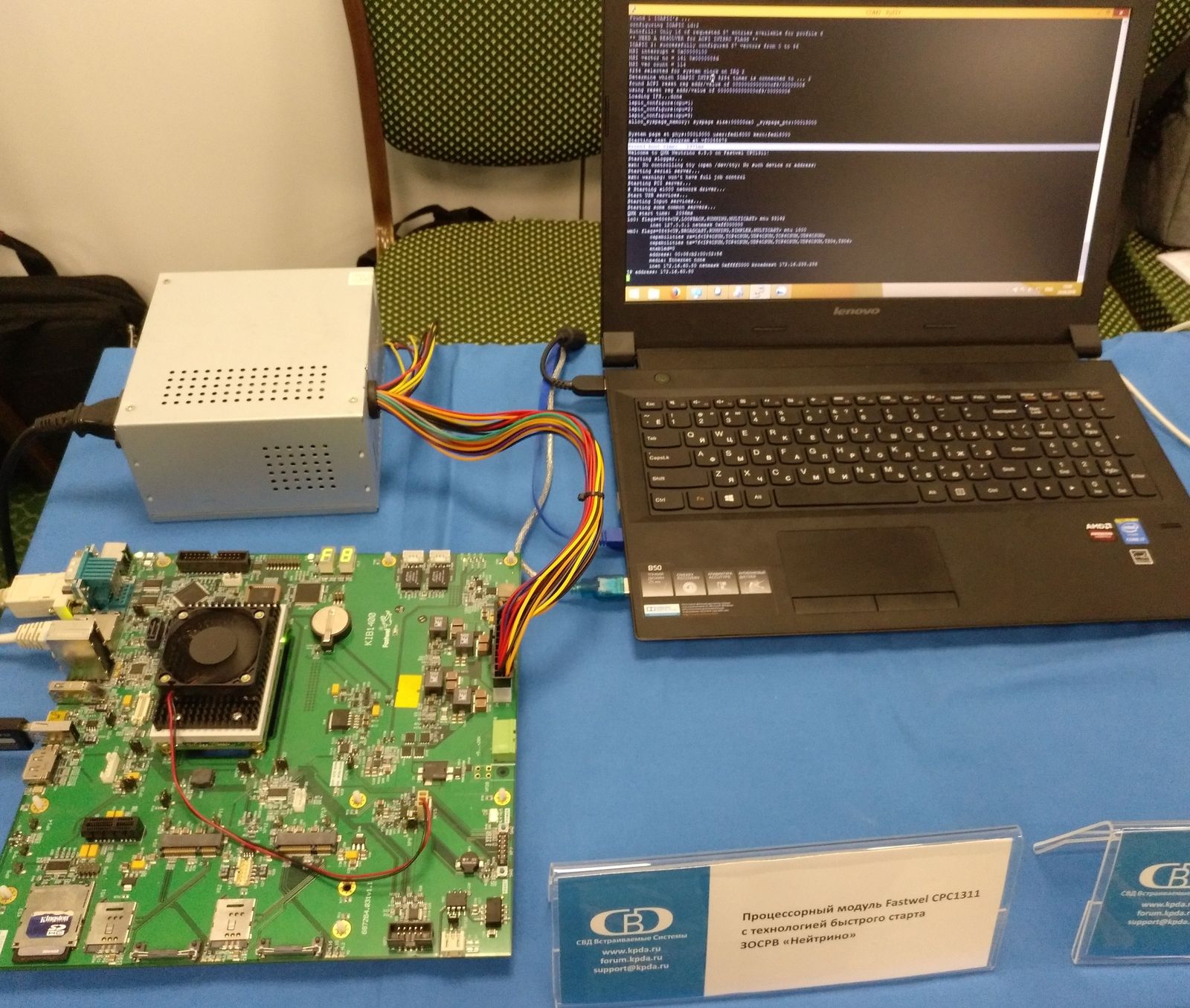 Photo: CPC1311 + KIB1400 set
Photo: CPC1311 + KIB1400 set
RTSoft presented a fanless industrial computer BLOK based on solutions from its technology partner Kontron. In addition, there was an interesting “box” KBoxA-203 , designed to collect data from sensors and actuators in real time and for pre-processing, before transferring data to the “cloud”, as well as many COM modules from Kontron.
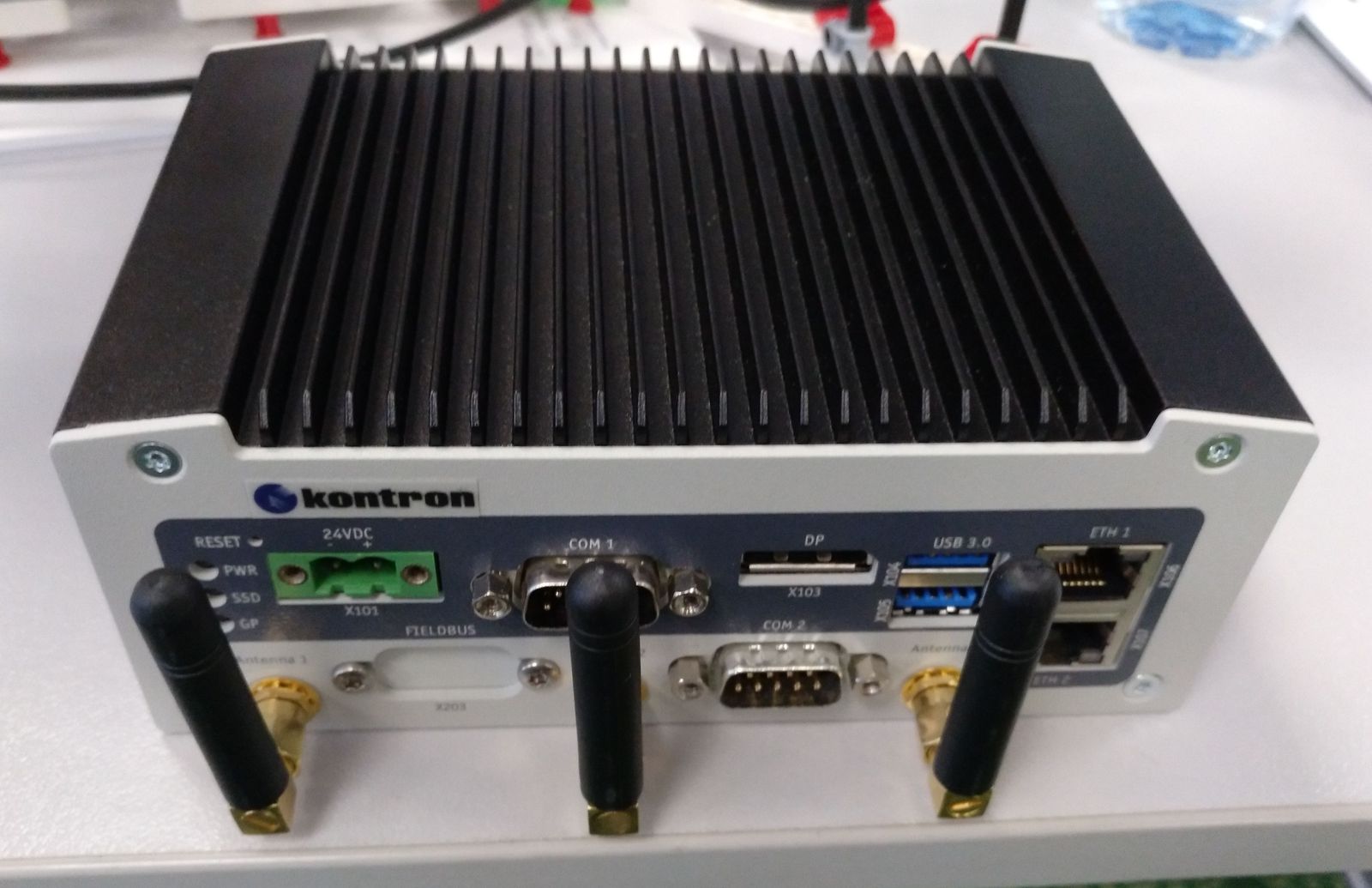 Photo: KBoxA-203
Photo: KBoxA-203
Equipment on Elbrus processors was represented both by products from the processor developer itself, and from independent companies.
Institute. I.S. Brooke demonstrated the work of protected industrial computers PC-2 and PC-3 for a process control system based on the Elbrus processor - 1C +. In particular, PC-3 launched a SCADA system simulating the operation of a certain technological process.
 Photo: PC-2
Photo: PC-2
 Photo: PC-3
Photo: PC-3
More information can be found with the products by downloading the catalog .
Next door is the Aquamarine company with a protected laptop, also based on the Elbrus processor - 1C +. The laptop has an extended operating temperature range from -20 ° C to + 55 ° C and protection level IP65, and two replaceable batteries. Battery life 3 hours. I have to say that the laptop is not light - 10 kg, but the company representatives assured that they already have a constructive solution to reduce the mass of the device. The remaining characteristics can be seen in the description on the developer's site.

At the booth of the SVD company, the focus control and control system KPDA KPDA.19801-01 was demonstrated, which was used to collect, process, analyze, visualize and store data of technological processes in real time, which was installed on the Fastwel processor module CPC514 Elbrus processor - 4. The module is designed according to the Compact PCI Serial specification in 3U format. Using the trunk-modular architecture, you can flexibly adapt the system to your needs, installing the necessary expansion modules, ranging from discrete I / O, to high-performance boards with FPGA or GPU.
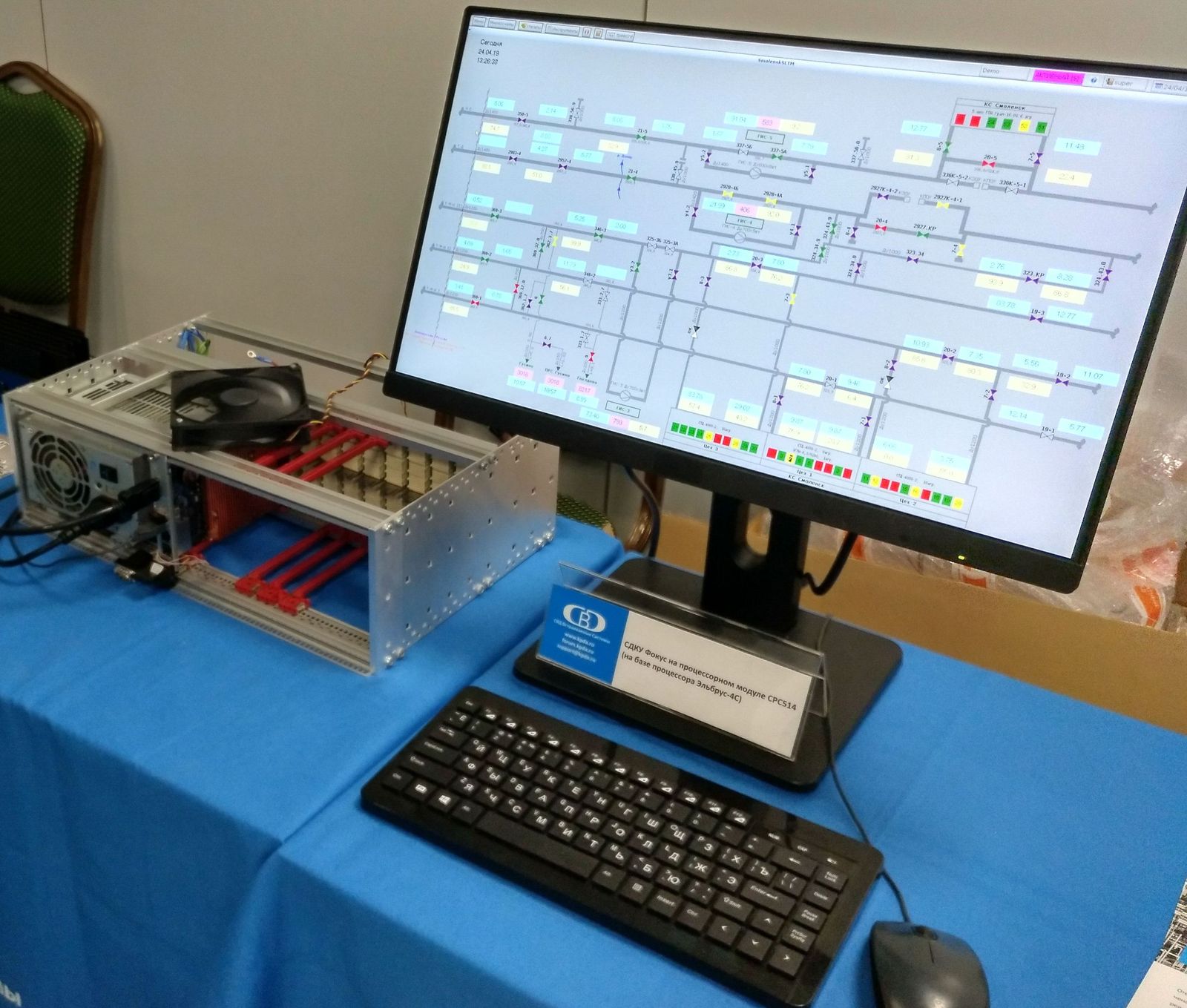 Photo: CPC514
Photo: CPC514
The manufacturer of industrial equipment MICROMAX proposed solutions using the MM-SVE single-board computer, which includes the Salyut processor module - EL24PM from the Elvis SPC and a PC / 104 carrier board with a set of peripherals. On the processor module itself, the 1892BM14Y processor is installed. Based on the MM-SVE computer, the company introduced two industrial computers M-Max 640MR and M-Max 651 MR.
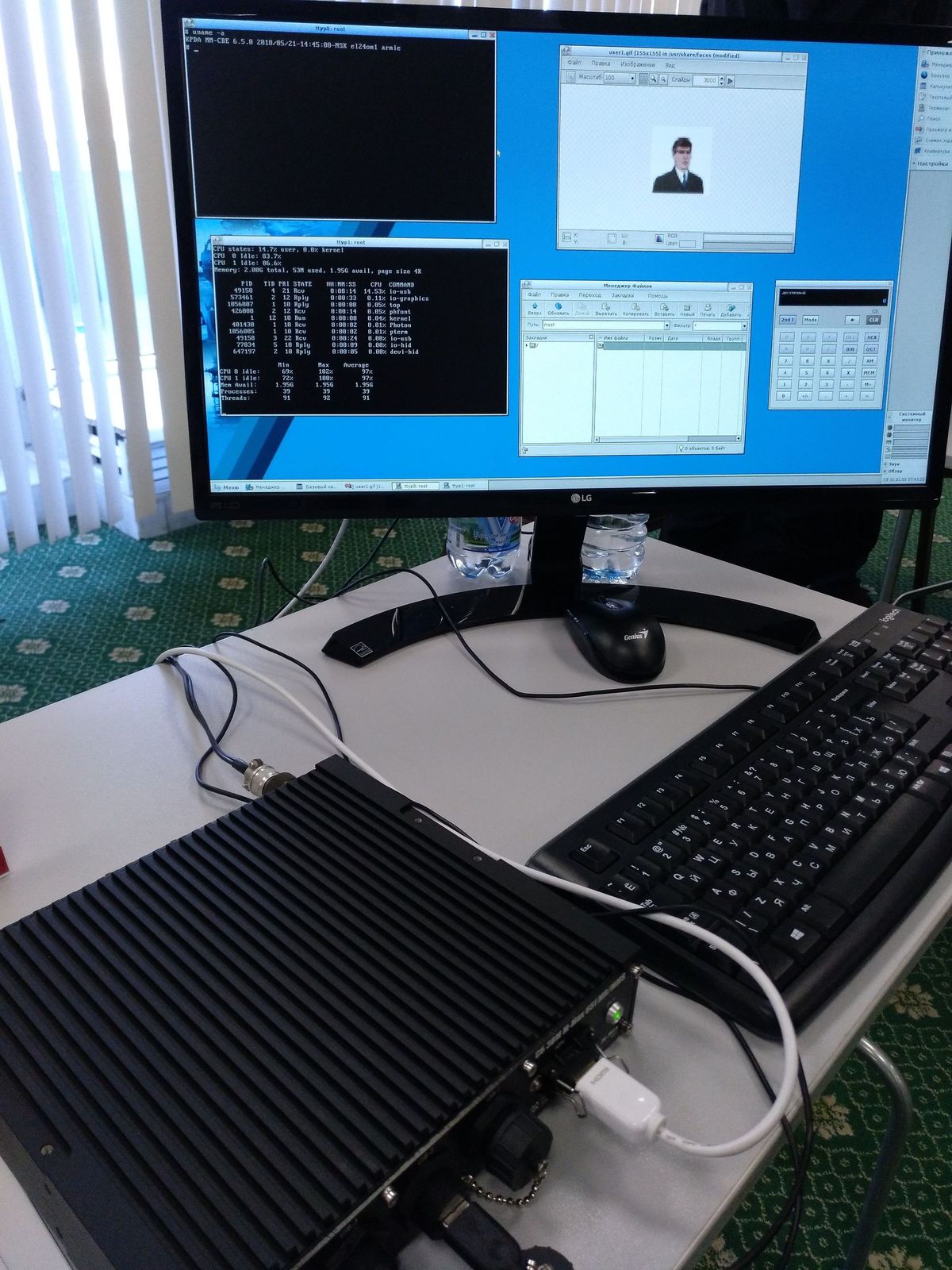 Photo: M-Max 651
Photo: M-Max 651
For the first time, Fastwel demonstrated an industrial modular computer MK150-02 on a Baikal-T1 processor for solving average performance tasks. Inside it is installed the CPC313 processor module and expansion cards. A feature of the MK150-02 is the presence of two Gigabit Ethernet ports, four RS-422/485 ports, two FBUS bus ports, and more.
 Photo: MK150-02
Photo: MK150-02
Above all, processor companies - STC ELVIS, NIIET, NIISI RAS - demonstrated desktop and debugging boards.
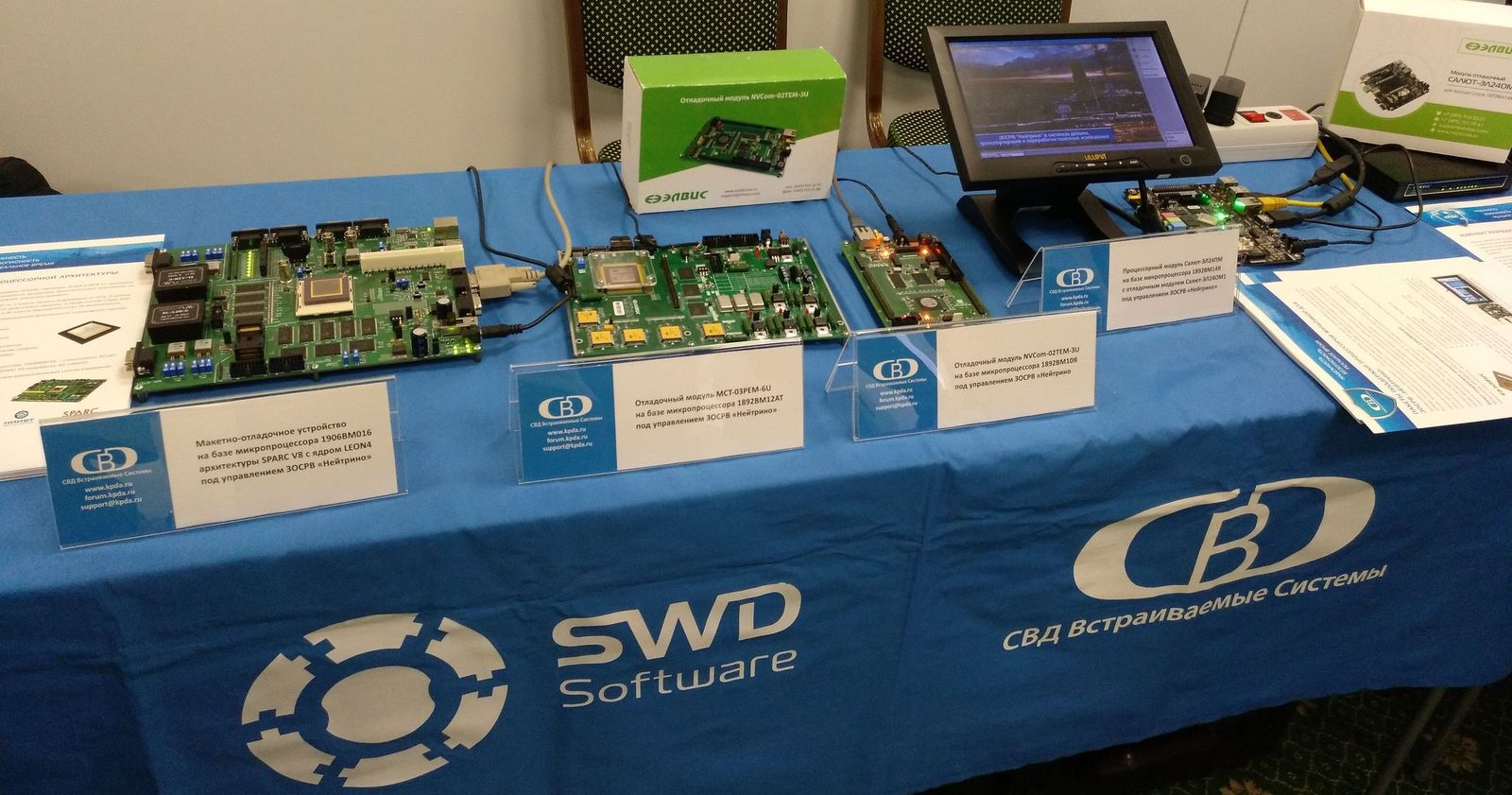

Details of the use of these processors can be found on the Internet.
SPC Elvis announced a radiation-resistant chip 1892VK016, designed to be used as a controller of a network solid-state information storage (SSD) terabyte capacity. The most interesting thing is that the controller has a SpaceFibre interface (optics) for data exchange with the Host. More information is available on the developer's site .
Of the high-performance - many already known Angar chip for high-speed interconnect between servers, computing clusters, etc., that is, is a kind of analogue or alternative to Infiniband and RapidIO. The developer is the company NIICEVT.
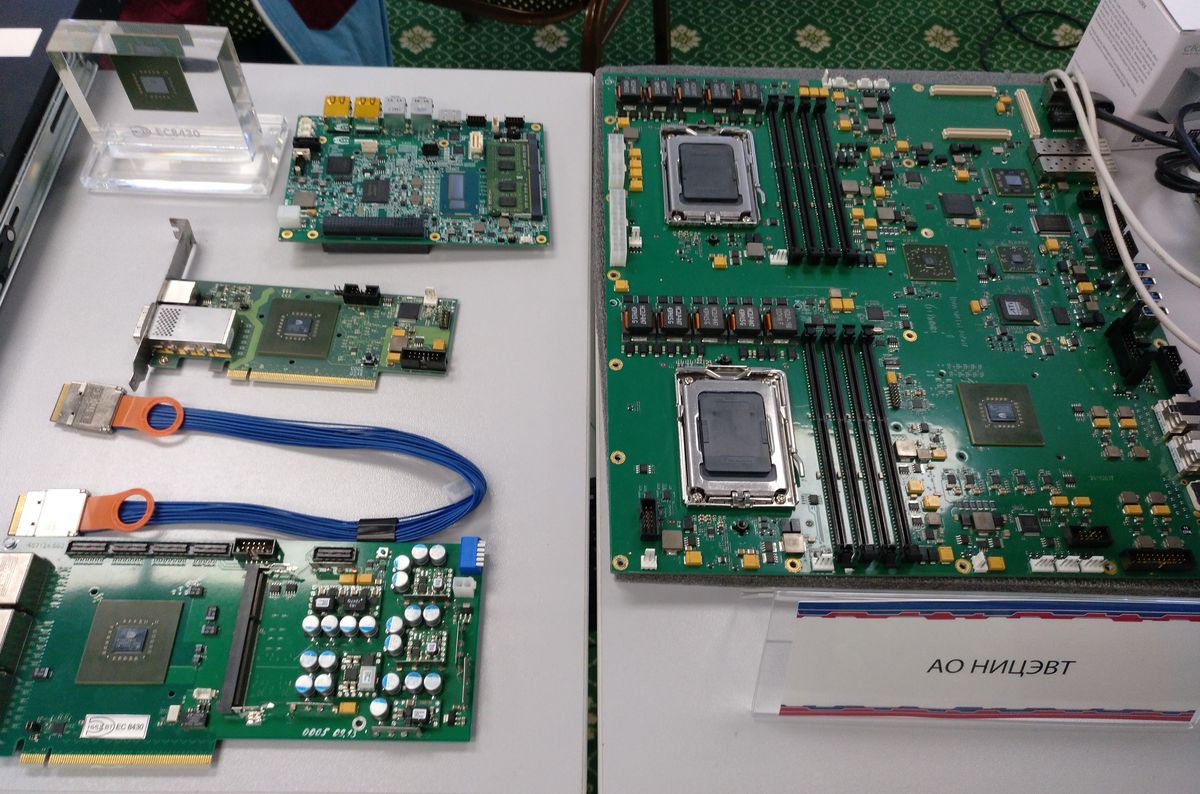
Presentations and presentations presented at the seminar can be downloaded from the SVD Embedded Systems website.
In addition to the seminar, a small demo zone was organized, where companies that somehow came into contact with the CPDA family of CPDA showed their solutions. In one place were collected components (processors) and equipment, which were presented mainly by Russian manufacturers of computer technology. Some of this has already been repeatedly covered either through press releases or on various information portals, but there was also something new.
A lot of photos!

As can be seen from the description on the developer's website , the EPRP EPRS family supports all the main processor architectures, which also produce industrial equipment in Russia. According to my subjective feelings, the largest number of complete commercial solutions that are available to consumers were on the x86 and Elbrus architecture, although there were MIPS, and ARM, and RISC, and SPARCv8.
The x86 was a development kit from the company Fastwel, running under the auspices of the Neurino ATP, and consisting of the COM Express Type 10 CPC1311 processor module on the Intel Atom platform and the KIB1400 media board.
')
 Photo: CPC1311 + KIB1400 set
Photo: CPC1311 + KIB1400 setRTSoft presented a fanless industrial computer BLOK based on solutions from its technology partner Kontron. In addition, there was an interesting “box” KBoxA-203 , designed to collect data from sensors and actuators in real time and for pre-processing, before transferring data to the “cloud”, as well as many COM modules from Kontron.
 Photo: KBoxA-203
Photo: KBoxA-203Equipment on Elbrus processors was represented both by products from the processor developer itself, and from independent companies.
Institute. I.S. Brooke demonstrated the work of protected industrial computers PC-2 and PC-3 for a process control system based on the Elbrus processor - 1C +. In particular, PC-3 launched a SCADA system simulating the operation of a certain technological process.
 Photo: PC-2
Photo: PC-2PC-2: characteristics
The processor: Elbrus-1 + (189111 - 1 core, 1000 MHz)
RAM: DDR3 ECC up to 8 GB, soldered to the board
Drive: 8–16 GB SSD, soldered to the board
Video: output to 2 high definition monitors 1920 × 1080 (Full HD)
External interfaces:
3 Ethernet channels with support for speeds of 10/100/1000 Mbit / s
2 USB 2.0 channels with support for speeds LS / FS / HS
2 RS-232C channels
2 RS-485 channels with galvanic isolation
4 general purpose input / output lines (GPIO)
Terms of Use:
temperature −40 ... + 50 °
sinusoidal vibration 1–200 Hz, 5 g
consumption not more than 30 W
RAM: DDR3 ECC up to 8 GB, soldered to the board
Drive: 8–16 GB SSD, soldered to the board
Video: output to 2 high definition monitors 1920 × 1080 (Full HD)
External interfaces:
3 Ethernet channels with support for speeds of 10/100/1000 Mbit / s
2 USB 2.0 channels with support for speeds LS / FS / HS
2 RS-232C channels
2 RS-485 channels with galvanic isolation
4 general purpose input / output lines (GPIO)
Terms of Use:
temperature −40 ... + 50 °
sinusoidal vibration 1–200 Hz, 5 g
consumption not more than 30 W
 Photo: PC-3
Photo: PC-3PC-3: Characteristics
The processor: Elbrus-1 + (189111 - 1 core, 1000 MHz)
RAM: DDR3 ECC up to 8 GB, soldered to the board
Drive: 8–16 GB SSD, soldered to the board
Video: output to 2 high definition monitors 1920 × 1080 (Full HD)
External interfaces:
2 video outputs with HDMI connectors
1 microphone input, 1 line output
3 channels of Ethernet support speeds of 10/100/1000 Mbit / s
6 channels USB 2.0 with support for speeds LS / FS / HS
2 RS-232C channels
2 RS-485/422 channels with galvanic isolation
8 general purpose input / output lines (GPIO)
Internal interfaces:
1 mSATA slot for additional drives
1 SATA slot for additional drives
Terms of Use:
temperature −40 ... + 50 ° C
humidity up to 80% non-condensing
sinusoidal vibration 5–500 Hz, 1 g
consumption up to 40 W
RAM: DDR3 ECC up to 8 GB, soldered to the board
Drive: 8–16 GB SSD, soldered to the board
Video: output to 2 high definition monitors 1920 × 1080 (Full HD)
External interfaces:
2 video outputs with HDMI connectors
1 microphone input, 1 line output
3 channels of Ethernet support speeds of 10/100/1000 Mbit / s
6 channels USB 2.0 with support for speeds LS / FS / HS
2 RS-232C channels
2 RS-485/422 channels with galvanic isolation
8 general purpose input / output lines (GPIO)
Internal interfaces:
1 mSATA slot for additional drives
1 SATA slot for additional drives
Terms of Use:
temperature −40 ... + 50 ° C
humidity up to 80% non-condensing
sinusoidal vibration 5–500 Hz, 1 g
consumption up to 40 W
More information can be found with the products by downloading the catalog .
Next door is the Aquamarine company with a protected laptop, also based on the Elbrus processor - 1C +. The laptop has an extended operating temperature range from -20 ° C to + 55 ° C and protection level IP65, and two replaceable batteries. Battery life 3 hours. I have to say that the laptop is not light - 10 kg, but the company representatives assured that they already have a constructive solution to reduce the mass of the device. The remaining characteristics can be seen in the description on the developer's site.

At the booth of the SVD company, the focus control and control system KPDA KPDA.19801-01 was demonstrated, which was used to collect, process, analyze, visualize and store data of technological processes in real time, which was installed on the Fastwel processor module CPC514 Elbrus processor - 4. The module is designed according to the Compact PCI Serial specification in 3U format. Using the trunk-modular architecture, you can flexibly adapt the system to your needs, installing the necessary expansion modules, ranging from discrete I / O, to high-performance boards with FPGA or GPU.
 Photo: CPC514
Photo: CPC514CPC514: Characteristics
The processor: Elbrus-4 (18918)
RAM: 1600 MHz DDR3 SDRAM with ECC 8 GB support, soldered, dual-channel
Drive: 16 GB SSD, soldered to the board
External interfaces:
1 channel video output DisplayPort (resolution up to 1920x1440)
2 channels of Ethernet support speeds of 10/100/1000 Mbit / s
2 USB 2.0 channels with support for speeds LS / FS / HS
Internal interfaces:
3 SATA channels for additional drives
2 channel PCI-E x4, Non-transparent mode support
6 channels PCI-E x2
Possibility to connect a mezzanine card with additional interfaces
Terms of Use:
Operating temperature range −40 ... + 85 ° C
Sinusoidal vibrations for frequencies from 10 to 150 Hz: with acceleration not exceeding 2 g;
Single shocks with a duration of 11 ms with a peak acceleration of no more than 50 g;
Multiple shocks with a duration of 6 ms with a peak acceleration of no more than 25 g.
Consumption not more than 54 W
RAM: 1600 MHz DDR3 SDRAM with ECC 8 GB support, soldered, dual-channel
Drive: 16 GB SSD, soldered to the board
External interfaces:
1 channel video output DisplayPort (resolution up to 1920x1440)
2 channels of Ethernet support speeds of 10/100/1000 Mbit / s
2 USB 2.0 channels with support for speeds LS / FS / HS
Internal interfaces:
3 SATA channels for additional drives
2 channel PCI-E x4, Non-transparent mode support
6 channels PCI-E x2
Possibility to connect a mezzanine card with additional interfaces
Terms of Use:
Operating temperature range −40 ... + 85 ° C
Sinusoidal vibrations for frequencies from 10 to 150 Hz: with acceleration not exceeding 2 g;
Single shocks with a duration of 11 ms with a peak acceleration of no more than 50 g;
Multiple shocks with a duration of 6 ms with a peak acceleration of no more than 25 g.
Consumption not more than 54 W
The manufacturer of industrial equipment MICROMAX proposed solutions using the MM-SVE single-board computer, which includes the Salyut processor module - EL24PM from the Elvis SPC and a PC / 104 carrier board with a set of peripherals. On the processor module itself, the 1892BM14Y processor is installed. Based on the MM-SVE computer, the company introduced two industrial computers M-Max 640MR and M-Max 651 MR.
 Photo: M-Max 651
Photo: M-Max 651For the first time, Fastwel demonstrated an industrial modular computer MK150-02 on a Baikal-T1 processor for solving average performance tasks. Inside it is installed the CPC313 processor module and expansion cards. A feature of the MK150-02 is the presence of two Gigabit Ethernet ports, four RS-422/485 ports, two FBUS bus ports, and more.
 Photo: MK150-02
Photo: MK150-02MK150-02: Characteristics
Processor: Baikal - T1 (BE-T1000)
RAM: 1600 MHz DDR3 SDRAM with ECC 4 GB support, soldered, dual-channel
Drive: 8 GB SSD, soldered to the board
External interfaces:
1 channel video output VGA (resolution up to 1920x1080)
2 channels of Ethernet support speeds of 10/100/1000 Mbit / s
2 RS-232 channels
4 channels RS-422/485
6 channels USB 2.0 with support for speeds LS / FS / HS
2 channel bus FBus
1 channel SD
Internal interfaces:
4 SATA channels for additional drives
4 channels mPCI-E x1 for enhanced functionality
24 channels discrete I / O
Terms of Use:
Operating temperature range −40 ... + 50 ° C
Sinusoidal vibrations for frequencies from 10 to 150 Hz: with an acceleration of not more than 5 g
Single shocks with peak acceleration of no more than 100 g
Repeated shocks with a peak acceleration of no more than 50 g
Supply voltage from 10.5V to 36V
Consumption is not more than 30 W
RAM: 1600 MHz DDR3 SDRAM with ECC 4 GB support, soldered, dual-channel
Drive: 8 GB SSD, soldered to the board
External interfaces:
1 channel video output VGA (resolution up to 1920x1080)
2 channels of Ethernet support speeds of 10/100/1000 Mbit / s
2 RS-232 channels
4 channels RS-422/485
6 channels USB 2.0 with support for speeds LS / FS / HS
2 channel bus FBus
1 channel SD
Internal interfaces:
4 SATA channels for additional drives
4 channels mPCI-E x1 for enhanced functionality
24 channels discrete I / O
Terms of Use:
Operating temperature range −40 ... + 50 ° C
Sinusoidal vibrations for frequencies from 10 to 150 Hz: with an acceleration of not more than 5 g
Single shocks with peak acceleration of no more than 100 g
Repeated shocks with a peak acceleration of no more than 50 g
Supply voltage from 10.5V to 36V
Consumption is not more than 30 W
Above all, processor companies - STC ELVIS, NIIET, NIISI RAS - demonstrated desktop and debugging boards.


Details of the use of these processors can be found on the Internet.
SPC Elvis announced a radiation-resistant chip 1892VK016, designed to be used as a controller of a network solid-state information storage (SSD) terabyte capacity. The most interesting thing is that the controller has a SpaceFibre interface (optics) for data exchange with the Host. More information is available on the developer's site .
Of the high-performance - many already known Angar chip for high-speed interconnect between servers, computing clusters, etc., that is, is a kind of analogue or alternative to Infiniband and RapidIO. The developer is the company NIICEVT.

Presentations and presentations presented at the seminar can be downloaded from the SVD Embedded Systems website.
Source: https://habr.com/ru/post/453908/
All Articles